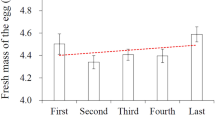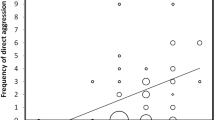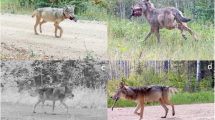Summary
On Skokholm Island, Wales, the young of the Oystercatcher (Haematopus ostralegus) are fully precocial, yet are totally dependent on parents for food. Though all young (commonly three) usually hatch within one day, small hatching intervals do exist, and first-hatched nestlings are usually slightly heavier at hatching than those hatched later. Firsthatched young and/or initially heavier young become socially dominant over their siblings; a stable, linear, non-aggressive social hierarchy among siblings develops, which determines the partition of food among them and results in unequal distribution when food is scarce. Food shortage impairs the growth rate of subordinate young. They are rather hungry and restless and consequently predation on them is higher than on dominant young.
It is proposed that Oystercatchers achieve effective brood-reduction by the parents' control of differential egg weight, by the eggs' hatching order, and by the young's acceptance of a non-aggressive social hierarchy. The latter is an adaptation associated with the unusual phenomenon of fully precocial wader young being exclusively fed by parents.
Similar content being viewed by others
References
Ashkenazie S, Safriel UN (1979) Breeding cycle and behavior of the Semipalmated Sandpiper at Barrow, Alaska. Auk 96:56–67
Fjeldså J (1973) Territory and the regulation of population density and recruitment in the horned grebe Podiceps auritus arcticus Boje, 1822. Vidensk Medd Dan Naturhist Foren 136:117–189
Lack D (1954) The natural regulation of animal numbers. Clarendon Press, Oxford
Lind H (1965) Parental feeding in the Oystercatcher. Dan Ornithol Foren Tidsskr 59:1–31
Meyburg B-U (1974) Sibling aggression and mortality among nestling eagles. Ibis 116:224–228
Miller RS (1973) The brood size of cranes. Wilson Bull 85:436–441
Procter DLC (1975) The problem of chick loss in the South Polar Skua Catharacta maccormicki. Ibis 117:452–459
Radesäter T (1974) On the ontogeny of orienting movements in the triumph ceremony of two species of geese (Anser anser and Branta canadensis). Behaviour 50:1–15
Rajala P (1962) On the ecology of the broods of Capercailfie (Tetrao urogallus), Black Grouse (Lyrurus tetrix), and Willow Grouse (Lagopys lagopus). Suom Riista 15:28–52
Safriel UN (1966) Food and survival of Oystercatcher chicks on Skokholm in 1965. Ibis 108:455
Safriel UN (1967) Population and food study of the Oystercatcher. PhD thesis, Oxford University
Simmons KEL (1974) Adaptations in the reproductive biology of the Great Crested Grebe. Br Birds 67:413–437
Author information
Authors and Affiliations
Rights and permissions
About this article
Cite this article
Safriel, U.N. Social hierarchy among siblings in broods of the oystercatcher Haematopus ostralegus . Behav Ecol Sociobiol 9, 59–63 (1981). https://doi.org/10.1007/BF00299854
Received:
Accepted:
Issue Date:
DOI: https://doi.org/10.1007/BF00299854




